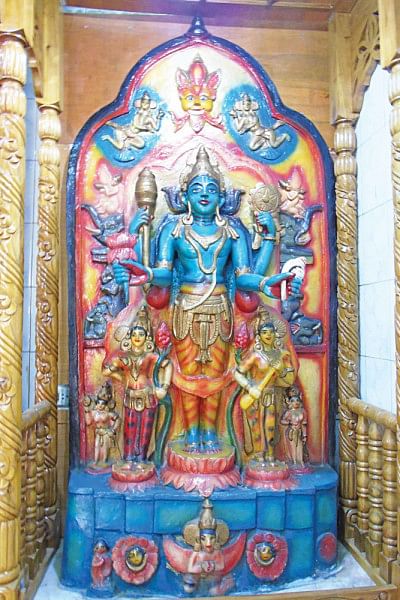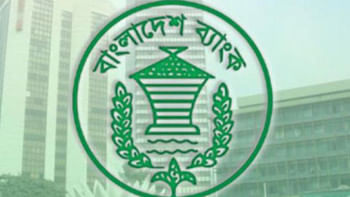Travel back in time with old sculptures


Four ages-old stone sculptures, so far academically unrecorded, have been found at a monastery in Sylhet city and can open up a new avenue of studying art and heritage of ancient Shrihatta.
These antiquities -- two Vishnu idols, a miniature Ganesh statue and a Shiva Lingam -- are worshipped by Hindu devotees at the Shree Shree Balaram Jeu Akhra (monastery) in Mirabazar area.
Some researchers think the Shiva Lingam could be from the period between 15th and 16th century and the three other sculptures from 10th to 12th century.
"These are very important antiquities for the history and heritage of Sylhet," said Prof Mozammel Hoque of archaeology department at Jahangirnagar University.
Historians and researchers said the Balaram Akhra was built around three hundred years ago by a zamindar named Madan Munsi.
Gopika Shyam Purkayastha, vice president of its managing committee, said one of the Vishnu idols was found during a re-excavation of a canal for renovation of a bridge in 1973. The same year, the second one was found while digging a pond near the monastery.
The height of both the idols is seven feet three inches.
The district administration took the two antiquities in its custody and handed them over to the Balaram Akhra after a decade. Cracks were found on the hands of both the idols and they were repaired and recoloured later on.
Talking to The Daily Star, Gopika Shyam said the Ganesh idol and Shiva Lingam were handed over to the monastery between '60s and '80s.
The managing committee has no information about how the Ganesh idol, which is two feet three inches tall, ended up here. "But it is sure that the donor was a resident of Sylhet town," said Gopika.

The Shiva Lingam, two fee one inch tall, was donated by Ashutosh Sharma, father of local freedom fighter Chandan Sharma, in 1965. It was in the family temple at their Raynagar residence, said Chandan's son Amitabh Sharma, a local school teacher.
Previously, four ancient Vishnu sculptures were found in Sylhet region.
Historian Kamalakanta Gupta Chowdhury in his book titled "Copper Plate of Sylhet", published in 1967, mentioned three of those. One was found at a pond in Ambarkhana area of Sylhet, the second at a temple in Jagannathpur of Sunamganj and the third at Panchakhanda Basudeva Angan in Beanibaza of Sylhet.
Panchakhanda Basudeva Angan, an ages-old temple, also houses idols of a Dhyani (meditating) Buddha and a Garudashin Vishnu (Lord Vishnu sitting or riding on Garuda, a mythical bird-like creature). The Daily Star ran a report on these two in October last year.
Vishnu is worshipped as the Supreme Lord by the followers of Vaishnavism, a major Hindu denomination alongside Shaivism, Shaktism, and Smartism.
And Shiva Lingam is a symbol that represents Lord Shiva.
Finding both the Vishnu idols and Shaiva sculptures in the same area suggests that there could be co-existence of followers of Vaishnavism and Shivaism in this region, said Prof Mozammel Hoque.
About the Shiva Lingam, Amitabh Sharma said, "It was worshiped at our family temple throughout generations. But we don't know anything about its age."
The history of Sharma Brahmins is very old in the region.
From the book "Copper Plate of Sylhet", it can be known that a large number of Sharma families used to live in this region in 10th century.
"From the Shiva Lingam's design, we can assume that it was made between 15th and 16th century," said Md Mosharaf Hossain, former director of the Department of Archaeology, a government body.
The Shiva Lingam has five layers that represent "Pancha Bhoota" or five great elements -- Earth, Water, Fire, Air and Space. Its presence in Sylhet points to the influence of South Indian followers of Shaivism in the region, he said.

Prof Mozammel Hoque said, "Such a Shiva Lingam is rare in Bangladesh; particularly there is no academic record of finding any Shaiva sculpture in Sylhet region."
On the other three sculptures, he said the designs of the idols suggest that they could be from 10th to 12th century.
"We did not find any documents mentioning these four ancient sculptures. Recovery of these sculptures hints that there might be more such antiquities in this region," he said.
"It has created a new horizon of historical and archaeological research in this region."
Dr Dilip Kumar Das Chowdhury, principal of Srihatta Sanskrit College in Sylhet, said ancient Srihatta was full of temples -- for followers of Vaishnavism, Shivaism and Shaktism.
So more antiquities may be found he if a proper excavation is initiated, he added.
[Tarun Sarkar is a freelance researcher and journalist who writes for The Daily Star]

 For all latest news, follow The Daily Star's Google News channel.
For all latest news, follow The Daily Star's Google News channel. 



Comments